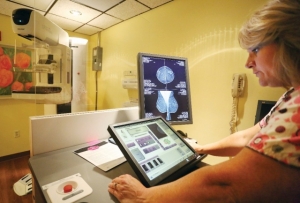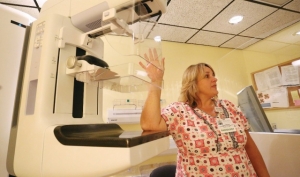3-D breast imaging offers early detection
By Becky Barclay
Published in News on January 25, 2016 1:46 PM

News-Argus/CASEY MOZINGO
Lisa Skinner an image created by the new 3-D Selenia Dimensions mammography machine at Wilmed Outpatient Imaging Center. Although the image created by the new machine looks similar to the old machine, the new machine takes images of layers throughout the breast, making it easier to see an abnormality.

News-Argus/CASEY MOZINGO
Lisa Skinner explains the differences between the old 2D breast imaging machine and the new 3-D Selenia Dimensions mammography machine. The new machine makes images of the breast in layers where the old machine only produces one image.
WILSON -- Early detection is vital in the treatment of breast cancer and advances in technology that produce more accurate and detailed results plays a key role in that diagnosis.
In Wilson, Wilmed Outpatient Imaging Center is one of the few places that offer 3-D mammography.
Wilmed uses the machine, Selenia Dimensions by Hologic, to offer its patients a more detailed look at the breast, which can result in a diagnosis of or breast cancer much earlier than 2-D images.
To do a 3-D image of the breast, the machine has a tube that goes to the left and right, then it comes back to the front for a regular 2-D image, said radiology services supervisor Lisa Skinner.
There are more benefits to a 3-D image versus a 2-D image.
"Doing 3-D, there are 40 percent more invasive cancers caught than with 2-D alone, and it finds cancers a lot earlier than a regular 2-D," Ms. Skinner said. "And there is 20 to 40 percent less chance of being called back for additional imaging. If you see an area on a mammogram, a lot of times when you have dense breast tissue, you can't see through that dense breast tissue. But 3-D can."
The difference with a 3-D mammography machine is that is takes images of the breast in one millimeter slices.
"The 3-D opens it up where you can see in between any dense breast tissue," Ms. Skinner said. "If you look at a book, you see the front and the back. You can't see through it because it may be thick. So you open the pages and see inside the book. That's what a 3-D imaging machine does.
"By looking at the beast tissue in one millimeter slices, the radiologist can provide a more confident assessment," Ms. Skinner explained.
She said the imaging for a 3-D scan is exactly the same as it is for a 2-D. The position of the breasts on the machine is the same. And the patient will feel the same amount of compression. The 3-D also does not give more radiation than the 2-D machine.
But the 3-D will be just a tiny bit faster.
It's all digital, so the images come out on the computer.
The machine can be used for any age and both females and males.
"The only way we'd do a male, though, is if he had a lump or a problem in his breast," Ms. Skinner said. "And if a patient has implants, we can use the 3-D to do that mammogram, too."
And it's not just for women who have dense breast tissue. It's for any woman.
Ms. Skinner said 75 percent of the center's patients prefer the 3-D machine.
And Wilmed's 3-D machine is different than some others where the technician has to put a special 3-D arm on the 2-D machine, then take it back off when done using it.
Wilmed's machine comes in one piece.
The 3-D mammogram usually costs about $60 more than a 2-D one.
"But Medicare is paying for the 3-D mammogram," Ms. Skinner said. "And other insurances are slowly picking that up, too.
"This is the latest and greatest machine that's out on the market. We just got ours at the end of March of this year."
Anyone wanting to make an appointment to have a 3-D mammogram at Wilmed Outpatient Imaging Center should call 252-399-8900.
